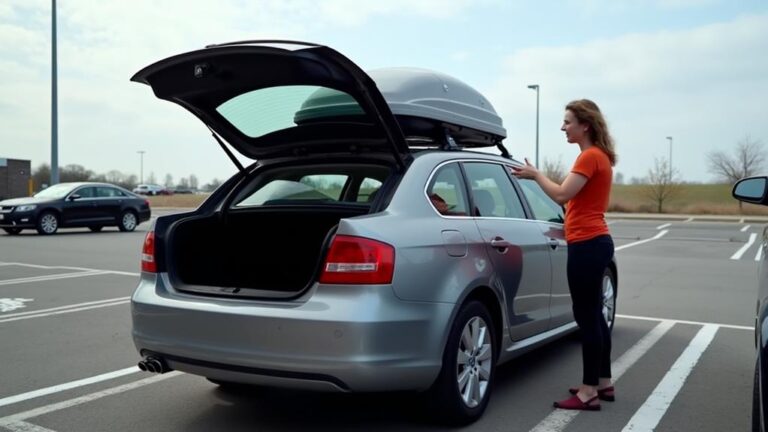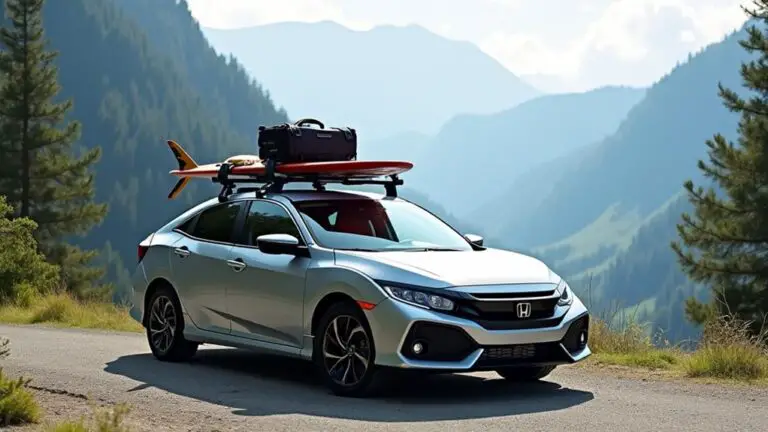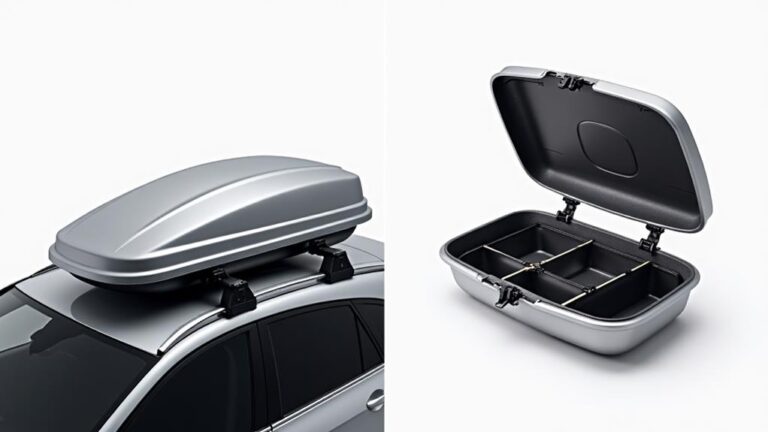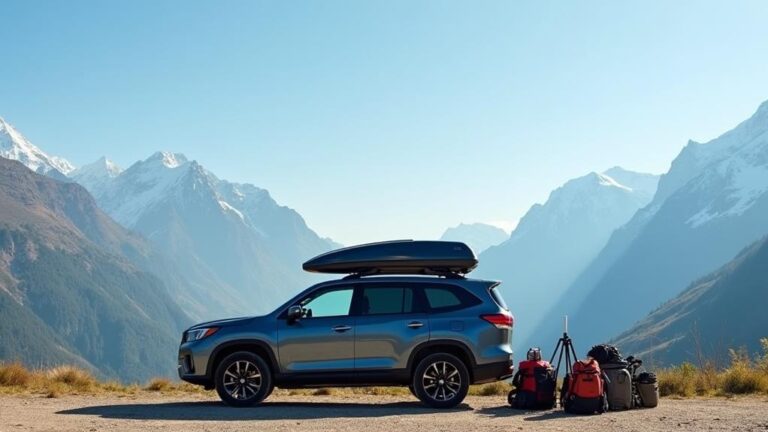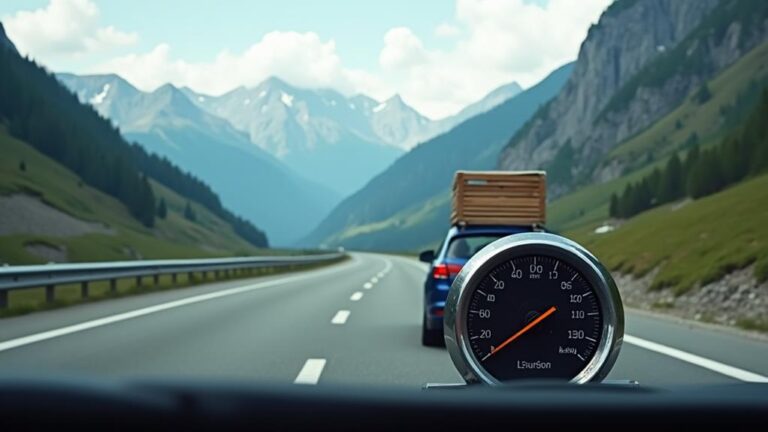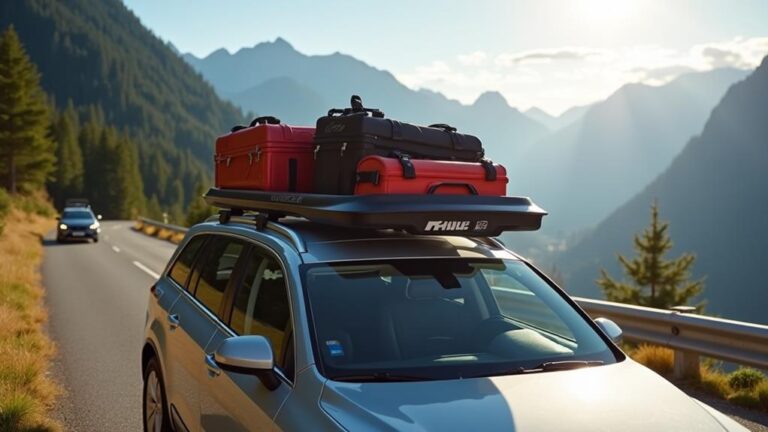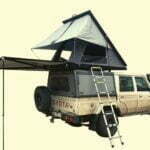You're finally ready to upgrade your in-game vehicle with a roof box in Car Parking Multiplayer, yet you can't even recall the last time you managed to park in real life without stalling. Don't worry, installing a roof box in the game is a relatively straightforward process. You'll need to start by accessing your car's menu to adjust settings that may impact roof box installation or use. But before you can get to that step, you'll need to make sure you have the right equipment – and that's exactly where many players get stuck.
Key Takeaways
- Access the in-game car customization menu to add a roof box to your vehicle.
- Choose a roof box that fits your car's make and model, considering size and weight capacity.
- Ensure the roof box is compatible with your car's roof rack in the game settings.
- Adjust the roof box's position and angle to ensure secure and balanced fit on the car.
- Verify the roof box is properly attached and doesn't obstruct car doors, sunroof, or other features.
Accessing the Car Menu
Accessing the car menu typically isn't a prerequisite for installing a roof box, but it can be useful in certain situations.
You may need to access the car menu if you want to adjust certain car settings that could impact the installation or use of your roof box. For example, you may need to adjust the car's automatic trunk or liftgate settings to ensure they don't interfere with the roof box.
To access the car menu, you'll typically need to use the car's infotainment system or a separate settings menu.
The exact steps will vary depending on your car's make and model, so you'll need to consult your owner's manual for specific instructions.
Once you've accessed the menu, you can browse through the various options to find the car settings that are relevant to your roof box installation.
Some common car settings that you may be able to adjust in the menu include vehicle customization options, such as roof rack settings or luggage capacity settings.
Purchasing a Roof Box
When purchasing a roof box, you'll need to consider the type of roof box that suits your vehicle and needs, such as a hard-shell, soft-shell, or hybrid model.
Key features to consider include the roof box's size, weight capacity, and locking mechanism.
You'll also have a range of brands to choose from, including Thule, Yakima, and Rhino-Rack.
Types of Roof Boxes
Your vehicle's roof type, driving habits, and cargo needs play a crucial role in selecting the right roof box for your car.
You'll need to consider roof box materials, which typically include ABS plastic, fiberglass, and polypropylene. ABS plastic is durable and UV-resistant, making it a popular choice.
Fiberglass is lightweight and offers excellent strength-to-weight ratio, while polypropylene is a budget-friendly option.
When it comes to roof box styles, you'll find options such as aerodynamic, symmetrical, and asymmetrical designs.
Aerodynamic roof boxes are streamlined to reduce wind resistance and noise, making them ideal for high-speed driving.
Symmetrical roof boxes offer balanced loading and are suitable for most vehicles.
Asymmetrical roof boxes provide more space on one side, making them perfect for cars with limited roof space or those who need to load bulky items.
Considering your vehicle's specific requirements and your driving habits will help you narrow down the options and choose the right roof box style and material for your needs.
Key Features to Consider
To ensure a roof box meets your needs, consider its key features before making a purchase.
You'll want to think about the roof design of your car and how the roof box will attach to it. Look for a roof box with a mounting system that's compatible with your car's roof type, whether it's a flush roof, raised roof rails, or a bare roof.
The size and capacity of the roof box are also crucial features to consider.
Think about the types of items you'll be carrying and the frequency of use. If you plan to use the roof box for long road trips or for carrying bulky car accessories, you'll want a larger capacity.
Other key features to consider include the roof box's aerodynamics, weight, and durability.
A sleek roof design can help reduce wind resistance and noise. Additionally, look for a roof box made from high-quality materials that can withstand various weather conditions.
Roof Box Brands Available
Now that you've identified the key features to consider when selecting a roof box, it's time to explore the various brands available on the market.
The roof box trends are constantly evolving, with manufacturers incorporating innovative designs and materials to cater to different needs and preferences.
You'll find a range of brands that offer high-quality roof boxes, each with their unique features and benefits.
Some notable roof box brands include:
- Thule: Known for their sleek and aerodynamic designs, Thule offers a wide range of roof boxes that cater to different vehicle types and sizes.
- Yakima: This brand is popular among outdoor enthusiasts, offering roof boxes that are designed to withstand harsh weather conditions and heavy use.
- Kamei: Kamei roof boxes are known for their durable and long-lasting construction, making them a popular choice among those who prioritize reliability and performance.
When selecting a roof box brand, consider factors such as durability, ease of installation, and compatibility with your vehicle.
Customizing Vehicle Options
Before installing a roof box on your car, consider customizing vehicle options to ensure compatibility and optimal performance. Customizing your vehicle can make a significant difference in how well the roof box fits and functions. You'll want to check the vehicle's weight capacity, roof type, and suspension to ensure they can support the roof box.
Some vehicle upgrades can also enhance the roof box's performance. Consider the following upgrades and their effects:
| Upgrade | Effect |
|---|---|
| Custom wheels | Can improve handling and stability with a roof box |
| Suspension upgrade | Can increase weight capacity and reduce swaying |
| Roof rack | Can provide additional support and stability for the roof box |
| Weight distribution | Can improve balance and reduce strain on the vehicle |
| Aerodynamics kit | Can reduce wind resistance and improve fuel efficiency |
When choosing upgrades, keep in mind the type and size of the roof box you plan to install. It's essential to research and consult with experts to ensure the upgrades are compatible with your vehicle and roof box. By customizing your vehicle options, you can ensure a safe and efficient installation process.
Attaching Roof Box Component
Attaching Roof Box Component
Most roof boxes come with multiple components, such as side rails, crossbars, and a main box unit.
To ensure a secure installation, you'll need to attach these components to your car's roof rack. Before starting, make sure your roof rack is compatible with the roof box you've chosen.
To attach the roof box component, follow these steps:
1. Check roof rack compatibility: Verify that your car's roof rack is compatible with the roof box's mounting system.
Consult your car's manual or the roof box manufacturer's website for more information.
2. Determine box weight capacity: Ensure the roof box's weight capacity matches the weight of the items you plan to store inside.
Exceeding the weight limit can compromise the roof box's stability and safety.
3. Mount the side rails: Attach the side rails to the roof rack, following the manufacturer's instructions.
Make sure they're securely fastened and evenly spaced to support the main box unit.
Adjusting Roof Box Position
You'll now need to adjust the roof box's position to ensure a secure and balanced fit on your car.
This involves centering the roof box, setting the optimal height and angle, and securing the position to prevent any movement during transit.
Centering the Roof Box
Centering the Roof Box
To achieve optimal stability and even weight distribution, position the roof box in the center of your car's roof rack.
Centering the roof box is crucial for maintaining roof balance tips and ensuring the box alignment tricks work effectively.
A centered roof box allows for even load distribution, reducing the risk of the box shifting or swaying while driving.
- Measure the roof rack: Measure the width of your car's roof rack to determine the center point. This will serve as a reference for positioning the roof box.
- Align the roof box: Place the roof box on the roof rack, ensuring it's aligned with the center point you measured earlier. Use the roof box's mounting points as a guide to secure it in place.
- Check the clearance: Verify that the roof box is centered and has adequate clearance from the car's roof, side rails, and other obstructions. A centered roof box will provide optimal stability and prevent damage to your car or the roof box.
Height and Angle
With the roof box centered on your car's roof rack, focus on adjusting its height to optimize aerodynamics and reduce wind noise.
Proper height adjustment is crucial to ensure sufficient roof clearance. Check your car's manual for the recommended minimum clearance to avoid any damage or obstruction. Typically, it's around 10-15 cm (4-6 inches) between the roof box and any overhead obstacles.
Next, make angle adjustments to the roof box to minimize wind resistance and noise.
The ideal angle varies depending on your car's design and the roof box model. As a general rule, the front of the roof box should be slightly lower than the rear. This helps to reduce wind noise and improve fuel efficiency.
You can use the roof rack's built-in angle adjustment features or purchase additional angle-adjusting accessories. Make sure to refer to your roof box manual for specific angle adjustment recommendations.
Securing the Position
Securing the Position
Adjusting the roof box position is critical to ensure it's securely fastened to your car's roof rack.
Once you've set the height and angle, it's time to fine-tune the roof box alignment to achieve a snug fit.
To do this, you need to ensure the roof box is centered and evenly spaced on the roof rack.
Check that the roof box is parallel to the car's roof and that the mounting points are aligned with the rack's crossbars.
- Roof box alignment: Ensure the roof box is centered on the roof rack, with even spacing on either side. This will help distribute the weight evenly and prevent the roof box from shifting during transport.
- Car clearance: Check that the roof box doesn't obstruct the car's doors, sunroof, or other features. You should have enough clearance to open the doors and sunroof without any obstructions.
- Mounting point alignment: Verify that the mounting points on the roof box are aligned with the rack's crossbars. This will ensure a secure fit and prevent the roof box from shifting or coming loose during transport.
Confirming Installation Success
You've completed the installation process, and now it's time to double-check that everything is properly in place.
To confirm installation success, you'll perform a series of installation checks and roof inspections.
Begin by visually inspecting the roof box for any signs of damage or misalignment.
Make sure it's centered and evenly spaced on your car's roof. Check the clamps, ensuring they're securely attached to the roof bars and the roof box is firmly held in place.
Next, inspect the roof bar attachment points, verifying they're tightened to the recommended torque specification.
If your roof box has any additional support or reinforcement, ensure these are properly secured as well.
Perform a final walk-around to ensure all latches, straps, and other securing mechanisms are engaged and functioning correctly.
Double-check the roof box's weight capacity isn't exceeded, as overloading can compromise the installation's stability.
Testing Roof Box Functionality
To ensure the roof box functions as intended, test its operation before loading and transporting it.
You'll want to verify that the roof box is securely attached to your vehicle and that it doesn't obstruct your view while driving. This step is crucial in maintaining game realism and safety in the Car Parking Multiplayer environment.
When testing the roof box functionality, pay attention to the following aspects:
- Opening and closing mechanism: Ensure that the roof box can be opened and closed smoothly, without any glitches or issues.
- Load capacity: Verify that the roof box can hold the intended load without causing any balance or stability issues to your vehicle.
- Collision detection: Test that the roof box interacts correctly with the environment, including other objects and vehicles, to maintain a realistic gameplay experience.
Frequently Asked Questions
Can I Put a Roof Box on Any Car in the Game?
You'll find that not all cars support roof boxes due to Car restrictions and Vehicle compatibility limitations. Before attempting to install, check the in-game vehicle specs to ensure the roof box is compatible with your chosen car.
How Do I Remove a Roof Box From My Car?
To remove a roof box, you'll need to access the box's security mechanism, then use specialized box removal tools to release the clamps and brackets holding it in place, allowing safe detachment.
Can I Use a Roof Box With a Bike Rack?
You can use a roof box with a bike rack, but ensure bike clearance isn't compromised and check rack compatibility first. Measure the roof box and bike rack to confirm they fit and function together seamlessly.
Does a Roof Box Affect Car Performance in the Game?
In racing games, a roof box generally affects car performance by altering game physics. It increases aerodynamic drag, which reduces speed and handling. You'll likely notice decreased acceleration and maneuverability, impacting overall driving experience.
Can Multiple Players Share a Single Roof Box?
In multiplayer settings, you can't virtually share a roof box among players due to individual inventory constraints. Online collaboration features don't extend to shared equipment usage, requiring each player to possess their own roof box.
Conclusion
You've managed to install a roof box in Car Parking Multiplayer – congratulations. This monumental achievement will undoubtedly be the envy of your fellow gamers. Pat yourself on the back for following basic instructions and successfully attaching a virtual box to your car's roof rack. Now, go forth and test its functionality, but don't get too excited – it's just a roof box. Ensure it's secure and functioning properly to avoid any in-game mishaps or embarrassment.
